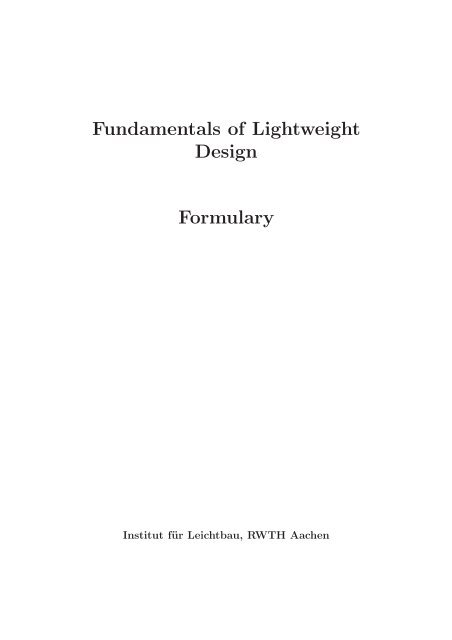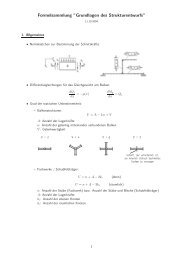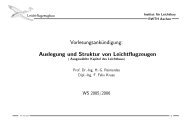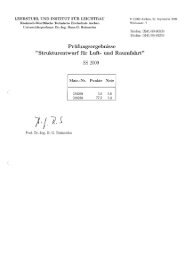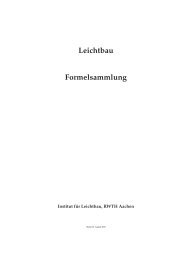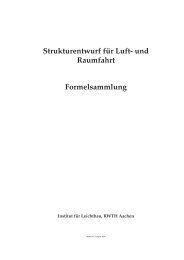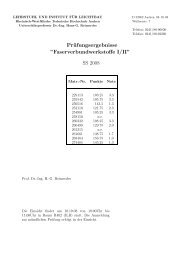Fundamentals of Lightweight Design Formulary - lehrstuhl und ...
Fundamentals of Lightweight Design Formulary - lehrstuhl und ...
Fundamentals of Lightweight Design Formulary - lehrstuhl und ...
Create successful ePaper yourself
Turn your PDF publications into a flip-book with our unique Google optimized e-Paper software.
<strong>F<strong>und</strong>amentals</strong> <strong>of</strong> <strong>Lightweight</strong><br />
<strong>Design</strong><br />
<strong>Formulary</strong><br />
Institut für Leichtbau, RWTH Aachen
Contents<br />
1 General Formulas 1<br />
2 Trusses 3<br />
3 Bending <strong>of</strong> Beams 4<br />
4 Transfer and Stiffness Matrices 10<br />
5 Beams Subjected to Transverse Shear Forces 12<br />
6 Torsion <strong>of</strong> Beams 18<br />
7 Stiffened Shear Webs 23
1 General Formulas<br />
1 General Formulas<br />
– numerical integration rule:<br />
f<br />
F i+1 =<br />
F i + 1 2 (f(z) i + f(z) i+1 ) · ∆z<br />
i i+1 z<br />
z<br />
– isotropic materials:<br />
– Hooke’s law (one-dimensional):<br />
G =<br />
E<br />
2(1+ν)<br />
σ x = ε x E<br />
– strain-deformation relation for a bar:<br />
ε x = du<br />
dx<br />
– standard box for the determination <strong>of</strong> cutting forces:<br />
– differential equations for the equilibrium <strong>of</strong> beams:<br />
dQ z<br />
dx = −p(x)<br />
dM y<br />
dx<br />
= Q z<br />
1
1 General Formulas<br />
– definition <strong>of</strong> Young’s moduli in the plastic range:<br />
· tangent modulus:<br />
E T = dσ<br />
dε<br />
· secant modulus<br />
E S = σ ε<br />
– stress-strain relation according to Ramberg-Osgood:<br />
· stress-strain relation:<br />
ε = σ 0,7<br />
E<br />
[ σ<br />
+ 3 ( ) σ n ]<br />
σ 0,7 7 σ 0,7<br />
; n =1+<br />
ln(<br />
17<br />
7 )<br />
ln( σ 0,7<br />
σ 0,85<br />
)<br />
· tangent modulus:<br />
E T =<br />
E<br />
1+ 3 7 n (<br />
σ<br />
σ 0,7<br />
) n−1<br />
· secant modulus:<br />
E S =<br />
1+ 3 7<br />
E<br />
( ) n−1 σ<br />
σ 0,7<br />
· σ 0,7 and σ 0,85 are defined as shown in the following figure:<br />
2
2 Trusses<br />
2 Trusses<br />
– degree <strong>of</strong> red<strong>und</strong>ancy:<br />
U = n + A − 2k<br />
U = n + A − 3k r − 2k e<br />
A: number <strong>of</strong> reaction forces<br />
n: number<strong>of</strong>bars<br />
k: number<strong>of</strong>nodes<br />
k r : number <strong>of</strong> three-dimensional nodes<br />
k e : number <strong>of</strong> two-dimensional nodes<br />
(two-dimensional)<br />
(three-dimensional)<br />
– equilibrium <strong>of</strong> nodes (two-dimensional):<br />
∑<br />
X = P cos(ϕ)+<br />
∑<br />
Ni cos(γ i )=0<br />
∑<br />
Y = P sin(ϕ)+<br />
∑<br />
Ni sin(γ i )=0<br />
– three-dimensional decomposition <strong>of</strong> a force / similarity <strong>of</strong> the bar force components<br />
(F ix , F iy , F iz ) to the bar lengths (l ix , l iy , l iz ):<br />
√<br />
l i = lix 2 + l2 iy + l2 iz<br />
cos α = F ix<br />
F i<br />
= l ix<br />
l i<br />
; cosβ = F iy<br />
F i<br />
= l iy<br />
; cosγ = F iz<br />
= l iz<br />
l i F i l i<br />
3
3 Bending <strong>of</strong> Beams<br />
3 Bending <strong>of</strong> Beams<br />
– statical moments <strong>of</strong> an area:<br />
∫<br />
S y =<br />
– moments <strong>of</strong> inertia <strong>of</strong> an area:<br />
∫<br />
I y =<br />
– product <strong>of</strong> inertia <strong>of</strong> an area:<br />
A<br />
A<br />
∫<br />
zdA S z =<br />
∫<br />
z 2 dA I z =<br />
∫<br />
I yz =<br />
A<br />
yz dA<br />
A<br />
A<br />
ydA<br />
y 2 dA<br />
– stress distribution for an arbitrary coordinate system in the center <strong>of</strong> gravity:<br />
σ x (z,y) = N A + M yI z + M z I yz<br />
I y I z − I 2 yz<br />
z − M zI y + M y I yz<br />
I y I z − Iyz<br />
2 y<br />
– stress distribution for a system <strong>of</strong> principal axes in the center <strong>of</strong> gravity:<br />
– section moduli:<br />
– polar moment <strong>of</strong> inertia:<br />
σ x (z,y) = N A + M y<br />
I y<br />
z − M z<br />
I z<br />
y<br />
W y =<br />
I y<br />
|z max |<br />
∫<br />
I p = I y + I z =<br />
– radii <strong>of</strong> gyration:<br />
i 2 y = I y<br />
A<br />
– location <strong>of</strong> the centroid <strong>of</strong> an area:<br />
∫<br />
A<br />
η s =<br />
ηdA<br />
A<br />
W z =<br />
A<br />
r 2 dA<br />
i 2 z = I z<br />
A<br />
ζ s =<br />
I z<br />
|y max |<br />
∫<br />
A ζdA<br />
A<br />
– coordinate transformation for a rotation <strong>of</strong> the coordinate system about ϕ:<br />
z = −y ′ sin ϕ + z ′ cos ϕ<br />
y = y ′ cos ϕ + z ′ sin ϕ<br />
4
3 Bending <strong>of</strong> Beams<br />
– theorem <strong>of</strong> Steiner:<br />
I η = I y ′ + ζ 2 s A I ζ = I z ′ + η 2 sA I ηζ = I y ′ z ′ + η sζ s A<br />
– change <strong>of</strong> the moments <strong>of</strong> inertia and <strong>of</strong> the product <strong>of</strong> inertia due to a rotation <strong>of</strong> the<br />
coordinate system:<br />
I y (ϕ) = 1 ( 1<br />
Iy ′ + I z ′)<br />
+<br />
2<br />
2<br />
I z (ϕ) = 1 ( 1<br />
Iy ′ + I z ′)<br />
−<br />
2<br />
2<br />
I yz (ϕ) = 1 (<br />
Iy ′ − I z ′<br />
2<br />
– location <strong>of</strong> the principal axes:<br />
– differential equation <strong>of</strong> the deflection line:<br />
( )<br />
Iy ′ − I z ′ cos 2ϕ − Iy ′ z ′ sin 2ϕ<br />
( )<br />
Iy ′ − I z ′ cos 2ϕ + Iy ′ z ′ sin 2ϕ<br />
)<br />
sin 2ϕ + Iy ′ z ′ cos 2ϕ<br />
tan 2α = − 2I y ′ z ′<br />
I y ′ − I z ′<br />
w ′′′′ I y E = p(x) ⇒ w ′′′ = − Q z<br />
I y E<br />
⇒<br />
w ′′ = − M y<br />
I y E<br />
Plastic Bending:<br />
– relation between longitudinal force and longitudinal stress:<br />
∫<br />
N = σ(z)dA<br />
– relation between bending moment and longitudinal stress:<br />
∫<br />
M = σ(z) · zdA<br />
A<br />
A<br />
– definitions:<br />
– interaction curves:<br />
ν =<br />
N<br />
µ = M<br />
A · σ B W · σ B<br />
· elastic material behaviour:<br />
ν + µ =1<br />
· ideal plastic material behaviour (valid only for a rectangular cross section):<br />
µ =6 ( κ − κ 2) }<br />
ν =(2κ − 1)<br />
⇒ µ =1.5 ( 1 − ν 2) 5
3 Bending <strong>of</strong> Beams<br />
– It applies for ν =0:<br />
· ideal plastic material behaviour:<br />
· Cozzone’s approximation:<br />
M plastic =<br />
M plastic = K · M elastic<br />
[<br />
1+(K − 1) σ ]<br />
o<br />
M elastic<br />
σ M<br />
· Values <strong>of</strong> K for some typical cross sections are given on page 9.<br />
6
3 Bending <strong>of</strong> Beams<br />
moments <strong>of</strong> inertia for typical cross sections:<br />
I y = ba3<br />
12<br />
I z = ab3<br />
12<br />
I y = ba3<br />
36<br />
I z = ab3<br />
48<br />
I y = I z = π 4<br />
( R<br />
4<br />
a − R 4 i<br />
)<br />
I y = π 4<br />
(<br />
aa b 3 a − a ib 3 i<br />
)<br />
I z = π 4<br />
(<br />
a<br />
3<br />
a b a − a 3 i b i)<br />
s<br />
thin-walled circle:<br />
y<br />
R<br />
I y = πR 3 s<br />
z<br />
I z = πR 3 s<br />
a<br />
thin-walled ellipse:<br />
y<br />
b<br />
I y = π 4 sb2 (b +3a)<br />
s<br />
z<br />
I z = π 4 sa2 (a +3b)<br />
7
3 Bending <strong>of</strong> Beams<br />
deflection lines for selected load cases:<br />
w =<br />
Fl<br />
6EI y<br />
x ( )<br />
2 3 − x l<br />
w = − M<br />
2EI y<br />
x 2<br />
(<br />
w =<br />
pl2<br />
24EI y<br />
x 2 6 − 4 x + ( ) )<br />
x 2<br />
l l<br />
w =<br />
(<br />
pl2<br />
120EI y<br />
x 2<br />
10 − 10 x l +5( x<br />
l<br />
) 2<br />
− ( ) )<br />
x 3<br />
l<br />
(<br />
x ≤ a : w = Flb<br />
6EI y<br />
x 1 − ( )<br />
b 2 (<br />
l − x<br />
) ) 2<br />
l<br />
(<br />
w = Fl2 a<br />
6EI y<br />
1 −<br />
x<br />
l<br />
x ≥ a :<br />
) ( 1 − ( a<br />
l<br />
) 2 ( ) )<br />
− 1 −<br />
x 2<br />
l<br />
w =<br />
pl3<br />
24EI y<br />
x ( 1 − x l<br />
) ( 1+ x − ( ) )<br />
x 2<br />
l l<br />
w =<br />
(<br />
pl3<br />
360EI y<br />
x<br />
7 − 10 ( x<br />
l<br />
) 2<br />
+3 ( ) )<br />
x 4<br />
l<br />
8
3 Bending <strong>of</strong> Beams<br />
values <strong>of</strong> K (plastic bending) for typical cross sections:<br />
sketch<br />
K<br />
thin web<br />
K =1.0<br />
[<br />
K =1.5<br />
]<br />
h 3 t 2 +4ht 1·(b−t 2 )(h−t 1 )<br />
h 3 t 2 +2t 1 (b−t 2 )(3h 2 −6ht 1 +4t 2 1 )<br />
K =1.5<br />
[ ]<br />
h 3 t 2 +ht 2 1 (b−t 2)<br />
h 3 t 2 +t 3 1 (b−t 2)<br />
K =1.5<br />
thin walled tubes<br />
K =1.27<br />
K =1.698 D(D3 −d 3 )<br />
D 4 −d 4<br />
K =1.698<br />
K =2.0<br />
9
4 Transfer and Stiffness Matrices<br />
4 Transfer and Stiffness Matrices<br />
Transfer Matrices {W } and State Vectors → u:<br />
– bar with a constant distributed longitudinal load:<br />
– shear-rigid beam:<br />
→<br />
u=<br />
⎡<br />
⎣<br />
u<br />
N<br />
1<br />
⎤<br />
⎧<br />
⎨<br />
⎦ {W } =<br />
⎩<br />
l<br />
1<br />
AE<br />
−p L l 2<br />
2AE<br />
0 1 −p L l<br />
0 0 1<br />
⎫<br />
⎬<br />
⎭<br />
⎡<br />
→ u= ⎢<br />
⎣<br />
w<br />
w ′<br />
M y<br />
Q z<br />
1<br />
⎤<br />
⎥<br />
⎦<br />
w = w B<br />
(a) transfer matrix for a constant distributed transverse load:<br />
⎧<br />
⎪⎩<br />
1 l<br />
−l 2<br />
2I yE<br />
0 1<br />
−l<br />
I yE<br />
−l 3<br />
6I yE<br />
−l 2<br />
2I yE<br />
⎪⎨<br />
{W } =<br />
0 0 1 l<br />
p 0 l 4<br />
24I yE<br />
p 0 l 3<br />
6I yE<br />
−p 0 l 2<br />
2<br />
0 0 0 1 −p 0 l<br />
0 0 0 0 1<br />
⎫<br />
⎪⎬<br />
⎪⎭<br />
(b) dot matrix {P } in order to consider the introduction <strong>of</strong> concentrated loads:<br />
⎧<br />
⎪⎨<br />
{P } =<br />
⎪⎩<br />
1 0 0 0 0<br />
0 1 0 0 0<br />
0 0 1 0 M<br />
0 0 0 1 −P<br />
0 0 0 0 1<br />
⎫<br />
⎪⎬<br />
⎪⎭<br />
10
4 Transfer and Stiffness Matrices<br />
– shear-flexible beam:<br />
⎡<br />
→ u= ⎢<br />
⎣<br />
w<br />
w ′ B<br />
M y<br />
Q z<br />
1<br />
⎤<br />
⎥<br />
⎦<br />
w = w B + w S<br />
⎧<br />
⎪⎩<br />
1 l<br />
−l 2<br />
2I yE<br />
0 1<br />
−l<br />
I yE<br />
(<br />
−l 3<br />
6I yE +<br />
⎪⎨<br />
{W } =<br />
0 0 1 l<br />
−l 2<br />
2I yE<br />
l<br />
A Qz G<br />
)<br />
(<br />
p 0 l 4<br />
I yE 24 − IyEl2<br />
2A Qz G<br />
p 0 l 3<br />
6I yE<br />
−p 0 l 2<br />
2<br />
0 0 0 1 −p 0 l<br />
0 0 0 0 1<br />
)<br />
⎫<br />
⎪⎬<br />
⎪⎭<br />
Stiffness Matrices:<br />
– shear-rigid beam with a constant distributed transverse load:<br />
⎡<br />
⎢<br />
⎣<br />
⎤<br />
Q 0<br />
M 0<br />
Q 1<br />
M 1<br />
⎥<br />
⎦ = EIy<br />
⎡<br />
⎧⎪<br />
12 −6l −12 −6l<br />
⎨<br />
⎫⎪<br />
−6l 4l 2 6l 2l 2 ⎬ ⎢<br />
l 3 ⎪ −12 6l 12 6l ⎣<br />
⎩ ⎪ ⎭<br />
−6l 2l 2 6l 4l 2<br />
w 0<br />
w ′ 0<br />
w 1<br />
w ′ 1<br />
⎤<br />
⎥<br />
⎦ + p 0l<br />
2<br />
⎡<br />
⎢<br />
⎣<br />
−1<br />
l<br />
6<br />
−1<br />
− l 6<br />
⎤<br />
⎥<br />
⎦<br />
11
5 Beams Subjected to Transverse Shear Forces<br />
5 Beams Subjected to Transverse Shear Forces<br />
Open Thin-Walled Sections:<br />
– shear flow formula:<br />
t = Q zS y<br />
I y<br />
– rules for a qualitative description <strong>of</strong> the shear flow distribution:<br />
(1) The shear flow is directly proportional to the statical moment.<br />
(2) At an open end the shear flow is equal to zero, as the statical moment is zero.<br />
(3) The shear flow behaves linearly along the section center line for center lines that<br />
are parallel to the line <strong>of</strong> zero stress.<br />
(4) The shear flow has a parabolic shape for center lines that are perpendicular to<br />
the line <strong>of</strong> zero stress, the slope<br />
· decreases for integration towards the line <strong>of</strong> zero stress (lever arm gets smaller)<br />
and<br />
· increases for integration away from the line <strong>of</strong> zero stress (lever arm gets<br />
larger).<br />
(5) If the cross section is symmetric to the line <strong>of</strong> zero stress, the shear flow will be<br />
symmetric as well.<br />
(6) The direction <strong>of</strong> the shear flow corresponds to the direction <strong>of</strong> the loading: theory<br />
<strong>of</strong> sources and drains.<br />
(7) At branching points use the correct signs when superposing the statical moments.<br />
12
5 Beams Subjected to Transverse Shear Forces<br />
– shear center:<br />
∫<br />
s<br />
resp.<br />
t(s)ρ(s)ds = Q z · e y<br />
e y = 1 I y<br />
∫<br />
s<br />
S y ρds<br />
Closed Thin-Walled Sections:<br />
– Bredt’s first formula:<br />
M t =2t 0 A<br />
– procedure for the shear flow calculation <strong>of</strong> closed sections (only valid, if there are no<br />
warping stresses, i.e. if the transverse force acts through the shear center or if the<br />
cross section is a cross section <strong>of</strong> zero warping):<br />
(1) The closed section is cut at any arbitrary point:<br />
⇒ open section: t ′ = QzSy<br />
I y<br />
(2) The shear flow t 0 is determined by the equality <strong>of</strong> twisting moments.<br />
∮<br />
Q z a = t ′ ρds +2At 0 = Q z e 1 +2At 0<br />
(3) The shear flows t ′ and t 0 are superposed.<br />
– condition for the determination <strong>of</strong> the shear center:<br />
ϑ ′ =0<br />
⇒<br />
∮ t<br />
′<br />
Q z<br />
∮ Sy<br />
+ t 0,SC<br />
I<br />
ds =0 ⇒ t 0,SC = −<br />
y Gh<br />
∮ ds<br />
Gh<br />
ds<br />
Gh<br />
13
5 Beams Subjected to Transverse Shear Forces<br />
– Using this relation, the shear center can be determined by the following equation:<br />
∮<br />
∮<br />
A Sy<br />
Q z e = t ′ I<br />
ρds +2t 0,SC A ⇒ e = e 1 − 2<br />
y Gh ds<br />
∮ ds<br />
Gh<br />
– condition for cross sections <strong>of</strong> zero warping:<br />
∫ 2<br />
1<br />
ds<br />
Gh = ∆A ∮<br />
A<br />
ds<br />
Gh<br />
Shear-Flexible Beams:<br />
– The deformation w B <strong>of</strong> shear-rigid beams is superposed by the shear deformation w S :<br />
w = w B + w S<br />
– Hooke’s law (dependence <strong>of</strong> the shear deformation on the shear stress):<br />
γ(z) = τ(z)<br />
G<br />
– average shear angle γ m and shear correction factor κ z :<br />
w ′ τ<br />
S = γ m = κ z<br />
G = κ Q z<br />
z<br />
AG<br />
– determination <strong>of</strong> κ z :<br />
κ z = A Iy<br />
2<br />
∫<br />
κ z = A I 2 y<br />
s<br />
∫<br />
z<br />
S 2 y<br />
B dz<br />
(solid cross sections)<br />
Sy<br />
2<br />
h ds (thin-walled cross sections) 14
5 Beams Subjected to Transverse Shear Forces<br />
– shear-bearing area:<br />
A Qz = A κ z<br />
– approximation for thin-walled cross sections:<br />
κ z =<br />
A<br />
∑<br />
Aweb<br />
– differential equation <strong>of</strong> shear-flexible beams:<br />
w ′′′′ = −<br />
p′′<br />
A Qz G + p<br />
I y E<br />
As bo<strong>und</strong>ary conditions the following expressions must be used:<br />
w or Q z = w ′ sA Qz G<br />
β = w ′ B = w′ − γ m or M y = −w ′′ B I yE<br />
15
5 Beams Subjected to Transverse Shear Forces<br />
shear center locations:<br />
e =<br />
3hb2<br />
ah s +6bh<br />
e = ab3 2<br />
b 3 1 + b3 2<br />
sin α − α cos α<br />
e =2R<br />
α − sin α cos α<br />
e =2R<br />
16
5 Beams Subjected to Transverse Shear Forces<br />
shear correction factors (η = a b ): κ z = κ y =1.11<br />
κ z = κ y =1.2<br />
κ z = η +2<br />
(6η + η 2 ) 2 (<br />
24 + 36η +12η 2 + 6 5 η3 )<br />
κ y =<br />
3(η +2) 3<br />
(2 + 5η +2η 2 ) 2 ( 1<br />
5 + 7<br />
10 η + 4 5 η2 + 1 4 η3 )<br />
κ z = η +2<br />
(6η + η 2 ) 2 (<br />
6+36η +12η 2 + 6 5 η3 )<br />
κ y = 3 (η +2)<br />
5<br />
κ z =<br />
12(η +1) 3<br />
η 2 (4 + 5η + η 2 ) 2 ( 1<br />
4 + 8 5 η + 7<br />
10 η2 + 1<br />
10 η3 )<br />
κ y = 6 (η +1)<br />
5<br />
y<br />
κ z = κ y =2.0<br />
z<br />
17
6 Torsion <strong>of</strong> Beams<br />
6 Torsion <strong>of</strong> Beams<br />
Twisting Moment:<br />
T = M t + Q y e z − Q z e y<br />
Saint Vénant’s torsion:<br />
– definitions:<br />
· torsional moment <strong>of</strong> an area:<br />
ϑ ′ =<br />
T<br />
GI T<br />
(I T ≠ I p )<br />
· torsional section modulus:<br />
– closed thin-walled sections:<br />
τ max =<br />
T W T<br />
· section modulus (h min : minimum wall thickness):<br />
W T =2Ah min<br />
· Bredt’s first formula:<br />
· Bredt’s second formula:<br />
M t =2t 0 A<br />
GI T = 4A2 ∮ ds<br />
Gh<br />
18
6 Torsion <strong>of</strong> Beams<br />
– prismatic bars <strong>of</strong> solid cross section:<br />
· circular solid section:<br />
· elliptical solid section:<br />
I T = π 2 R4<br />
W T = π 2 R3<br />
I T = π a3 b 3<br />
a 2 + b 2<br />
W T = πab2<br />
2<br />
· rectangular solid section:<br />
I T = η 1<br />
B 3 H<br />
3<br />
W T = η 2<br />
B 2 H<br />
3<br />
H/B η 1 η 2<br />
1 0.4217 0.6245<br />
1.25 0.5152 0.6636<br />
1.5 0.5873 0.6929<br />
2 0.6860 0.7376<br />
3 0.7900 0.8016<br />
4 0.8424 0.8450<br />
5 0.8745 0.8740<br />
6 0.8951 0.8950<br />
8 0.9212 0.9212<br />
10 0.9370 0.9370<br />
∞ 1.0000 1.0000<br />
19
6 Torsion <strong>of</strong> Beams<br />
– approximations:<br />
· narrow rectangular section:<br />
I T = 1 3 B3 H<br />
W T = B2 H<br />
3<br />
τ = τ max<br />
2y<br />
B<br />
· thin-walled open sections:<br />
1 ∑<br />
I T = η 3 h 3 i l i<br />
3<br />
W T = I t<br />
=<br />
h max η ∑<br />
3<br />
h 3 i l i<br />
3h max<br />
i<br />
i<br />
section shape L U Z T I X<br />
η 3 0.99 1.12 1.12 1.12 1.30 1.17<br />
· thick-walled hollow sections:<br />
ϑ ′ = ϑ ′ B = ϑ′ i<br />
T = T B + ∑ i<br />
T i<br />
⎫<br />
⎬<br />
⎭ ⇒ I T = I TB + ∑ i<br />
I Ti<br />
τ max,i =<br />
3T i<br />
η 2i h 2 i l i<br />
τ Bi =<br />
T B<br />
2HBh i<br />
20
6 Torsion <strong>of</strong> Beams<br />
Restrained-Warping Torsion<br />
– twisting moments due to Saint Venant’s torsion M SV and due to bending torsion M B :<br />
M SV = ϑ ′ GI T<br />
M B = −ϑ ′′′ C T E<br />
– differential equation <strong>of</strong> restrained-warping torsion:<br />
d 3 ϑ dϑ<br />
− α2<br />
dξ3 dξ = −µ<br />
with<br />
ξ = x l<br />
α 2 = GI T l 2<br />
EC T<br />
µ = Tl3<br />
EC T<br />
– solution for a clamped cantilever beam subjected to a constant twisting moment:<br />
with<br />
ϑ = A 1 + A 2 cosh αξ + A 3 sinh αξ + µ α 2 ξ<br />
A 1 = −A 2 = − µ α 3 tanh α A 3 = − µ α 3 21
6 Torsion <strong>of</strong> Beams<br />
warping resistance C T :<br />
C T = a 2 I F 1I F 2<br />
I F 1 + I F 2<br />
C T = a 2 b 2 A F<br />
( 1<br />
6 −<br />
)<br />
A F<br />
8A F +4A S<br />
(<br />
)<br />
C T = a 2 b 2 1<br />
A F<br />
6 − A F<br />
8A F + 4 3 A S<br />
22
7 Stiffened Shear Webs<br />
7 Stiffened Shear Webs<br />
Open Stiffened Shear Webs<br />
– shear flow:<br />
t = Q a<br />
– longitudinal force in the flanges:<br />
N = M y<br />
a<br />
A<br />
– shear center:<br />
Q<br />
a<br />
e = 2A a<br />
e<br />
Closed Stiffened Shear Webs with 2 Flanges<br />
– determination <strong>of</strong> the shear flow distribution<br />
· method 1:<br />
Q = Q 1 + Q 2 ; Qd = Q 1 e 1 − Q 2 e 2<br />
23
7 Stiffened Shear Webs<br />
· method 2:<br />
Two-Dimensional Stiffened Shear Webs<br />
– degree <strong>of</strong> red<strong>und</strong>ancy:<br />
U = S + B + A − 2k<br />
S: number<strong>of</strong>bars<br />
B: number<strong>of</strong>panels<br />
A: number <strong>of</strong> reaction forces<br />
k: number<strong>of</strong>nodes<br />
– determination <strong>of</strong> the longitudinal bar forces:<br />
N(x) =<br />
– rectangular webs:<br />
∫ x<br />
0<br />
tdx + N 0<br />
t = t 1 = t 2 =<br />
t 3 = t 4 =<br />
const.<br />
24
7 Stiffened Shear Webs<br />
– parallelogram webs:<br />
t = t 1 = t 2 =<br />
t 3 = t 4 =<br />
const.<br />
n x =2t tan ϕ<br />
– trapezoidal webs:<br />
· definition <strong>of</strong> mean shear flow:<br />
t =<br />
∫ l<br />
0 t(x)dx<br />
l<br />
· determination <strong>of</strong> the mean shear flows:<br />
t 3<br />
t 1<br />
=<br />
(<br />
a1<br />
a 3<br />
) 2<br />
t 1<br />
t 2<br />
= t 4<br />
t 3<br />
= a 3<br />
a 1<br />
t 2 = t 4<br />
· The shear flows along the edges 1 and 3 are constant:<br />
t 1 = t 1 = const.<br />
t 3 = t 3 = const.<br />
· shear flow distribution along the edges 2 and 4:<br />
( ) 2 ( )<br />
a3<br />
d<br />
2<br />
t(x) =t 3 = t 3<br />
a(x) d + x<br />
t(x) =t m<br />
a 1 a 3<br />
a(x) 2 t m = √ t 2 t 4 = √ t 1 t 3<br />
· longitudinal force in the bars 2 and 4:<br />
N 2 (x) =N 20 + t 3<br />
cos α<br />
1+ x l<br />
x<br />
( ) N 4 (x) =N 40 − t 3<br />
a1<br />
a 3<br />
− 1<br />
cos β<br />
1+ x l<br />
x<br />
( )<br />
a1<br />
a 3<br />
− 1<br />
25
7 Stiffened Shear Webs<br />
– general quadrangular webs:<br />
A = t 1 p A p B = t 2 p B p C =<br />
t 3 p C p D = t 4 p D p A<br />
t m = √ t 2 t 4 = √ t 1 t 3<br />
· shear flow along the edge i:<br />
t i (u i )=<br />
t i0<br />
[<br />
1+(<br />
pil<br />
p i0<br />
− 1<br />
) ] 2 ui<br />
l i<br />
t i0 = A p 2 i0<br />
· longitudinal force in the bar i:<br />
N i (u i )=N i0 +<br />
t i0 u i<br />
1+(<br />
pil<br />
p i0<br />
− 1<br />
)<br />
ui<br />
l i<br />
Three-Dimensional Stiffened Shear Webs<br />
– degree <strong>of</strong> red<strong>und</strong>ancy:<br />
U = S + B + A − 3k r − 2k e<br />
S: number<strong>of</strong>bars<br />
B: number<strong>of</strong>panels<br />
A: number <strong>of</strong> reaction forces<br />
k r : number <strong>of</strong> three-dimensional nodes<br />
k e : number <strong>of</strong> two-dimensional nodes<br />
26
7 Stiffened Shear Webs<br />
shear center locations for some web shapes:<br />
straight<br />
web<br />
arbitrary<br />
shape<br />
parabula semicircle large arc<br />
e =0 e =2 A H<br />
e = 4a 3<br />
e = π 2 R<br />
e = 2A<br />
H t<br />
Q = tH Q = tH Q = tH Q = tH Q = tH t<br />
M αt =0<br />
M αt = M αt = M αt =<br />
2At<br />
4<br />
3 Hat R 2 πt<br />
M αt =2At<br />
load bearing capabilities <strong>of</strong> stiffened shear webs:<br />
longitudinal force<br />
in the centroid <strong>of</strong><br />
the flanges<br />
transverse parallel to<br />
force in 1-1<br />
X<br />
X<br />
X X X X X<br />
X<br />
X X<br />
X<br />
the shear arbitrary<br />
center direction<br />
X X X X<br />
perpendicular<br />
to 1-1<br />
bending<br />
X X X<br />
moment arbitrary<br />
direction<br />
X X X X<br />
twisting moment X X X X X<br />
27


